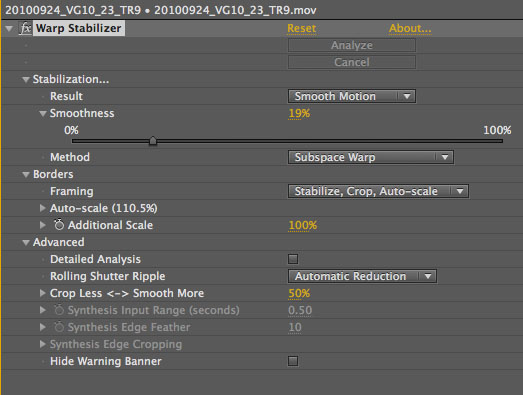
- Warp stabilizer slow how to#
- Warp stabilizer slow 1080p#
- Warp stabilizer slow full#
- Warp stabilizer slow software#
Gyroscopic stabilization smooths out all the bumps with linear motion, and rotation to produce a shot that looks a whole heck of a lot like it was filmed on a steadicam.ģ-axis gimbals are pretty amazing, and do a really fantastic job canceling out the operator’s motion, but typically just with wider lenses. SteadyShot can sometimes work well with forward and backward movement, but when rotation is added it doesn’t handle it well at all.It isn’t guessing, it’s using facts and information. Warp stabilizing produces artifacts that sometimes look cool and sometimes look totally bizarre, but the catalyst system is perfect because it’s using recorded metadata.If you’re wondering if this ‘extra step’ in stabilizing your footage is worth it or if you should just stick with the usual methods, skip ahead to 3:28 in Brandon’s video to see some comparisons that might make your jaw drop. I hope that in the near future we’ll see plug-ins for Premiere Pro, but as of right now this is how it is done if you’re looking to get some amazing results.
Warp stabilizer slow software#
The Catalyst Browse software is very barebones and intended strictly to process this metadata. Less shake means more crop, and more crop means a loss in resolution. Zoom out until you start to see the shake reappear, then zoom back just far enough o eliminate it. This will open your crop factor settings and allow you to zoom out. Just click the “i” icon in the upper-righthand corner to adjust. Select the clip you want, set in/out points as needed, and click stabilize.īy default, the software will zoom all the way in, over stabilizing the footage. If there is no icon next to the footage, there is no metadata recorded with the file.


Shoot some footage, and load it into your system as usual then launch Catalyst Browse.Ĭlips with a shaky filmstrip icon next to them contain the necessary metadata to stabilize the footage in this method. Typically we want to shoot at a shutter speed that is twice our frame rate, so this is a drawback in terms of how the motion in our footage will look. HOW IT WORKSįirstly, to use this system you have to turn off all in-body stabilization, and shoot at the highest shutter speed possible to avoid motion blurring. Information from the gyroscope, inside the camera, is recorded along with your images and you determine how stabilization is applied after the fact.
Warp stabilizer slow how to#
Since this post stabilization method doesn’t rely on the computer to track the objects in the frame and make a best-guess to determine how to smooth out shaky footage, it is faster, highly more accurate, and presents less weird artifacts like the ones we see with the Warp Stabilizer in Premiere Pro. It is currently available in the Sony A7sIII, ZV-1, FX-9, and RXO II. Gyroscopic stabilization is post stabilization that is aided through recorded camera positioning information that is stored as metadata in the clips you capture. If you haven’t subscribed to Brandon’s channel, you’re doing yourself a disservice – he is a super creative dude, and his videos are outstanding. They may seem to defy logic, but they produce some absolutely stunning results. We’ve covered Brandon Li’s amazing DIY rigs in the past. Master of creative DIY camerawork, Brandon Li takes us on a guided tour of how we can potentially ditch some of the devices that are holding us back and achieve astonishingly smooth, stable footage while shooting handheld on a Sony A7sIII thanks to gyroscopic stabilization. We’ve seen glimpses of that future here and there, with smart autofocus systems, widespread adoption of raw recording, and light field technology demonstrations, but now we’re one practical step closer to the inevitable future of computational cinematography. Raising RAM for “other” apps doesn’t work either.A revolution in cinematography is on the horizon, one that will not be driven by tools, crews, or budgets but by the sheer creativity of the operator, using nothing but their hands and minds to breathe life into their imagination. All use one instance of Adobe Analysis Server.
Warp stabilizer slow 1080p#
Blake has had success with 1080p 30k frame clips though (I wonder how long that took). Adobe recommends less than 7000 frames per clip. Looks like a few clips can be analyzed at once, but may run into memory and disc cache issues.
Warp stabilizer slow full#
Can handle full res RED files, but takes even longer.

Overall, slower than FCP7, FCPX and ProDAD, but results are very good (looks like Magic Bullet Steady is no longer available).



 0 kommentar(er)
0 kommentar(er)
